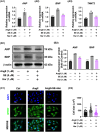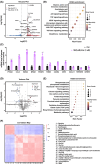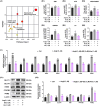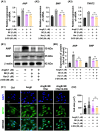The enhancing effects of selenomethionine on harmine in attenuating pathological cardiac hypertrophy via glycolysis metabolism
- PMID: 39351650
- PMCID: PMC11443162
- DOI: 10.1111/jcmm.70124
The enhancing effects of selenomethionine on harmine in attenuating pathological cardiac hypertrophy via glycolysis metabolism
Abstract
Pathological cardiac hypertrophy, a common feature in various cardiovascular diseases, can be more effectively managed through combination therapies using natural compounds. Harmine, a β-carboline alkaloid found in plants, possesses numerous pharmacological functions, including alleviating cardiac hypertrophy. Similarly, Selenomethionine (SE), a primary organic selenium source, has been shown to mitigate cardiac autophagy and alleviate injury. To explores the therapeutic potential of combining Harmine with SE to treat cardiac hypertrophy. The synergistic effects of SE and harmine against cardiac hypertrophy were assessed in vitro with angiotensin II (AngII)-induced hypertrophy and in vivo using a Myh6R404Q mouse model. Co-administration of SE and harmine significantly reduced hypertrophy-related markers, outperforming monotherapies. Transcriptomic and metabolic profiling revealed substantial alterations in key metabolic and signalling pathways, particularly those involved in energy metabolism. Notably, the combination therapy led to a marked reduction in the activity of key glycolytic enzymes. Importantly, the addition of the glycolysis inhibitor 2-deoxy-D-glucose (2-DG) did not further potentiate these effects, suggesting that the antihypertrophic action is predominantly mediated through glycolytic inhibition. These findings highlight the potential of SE and harmine as a promising combination therapy for the treatment of cardiac hypertrophy.
Keywords: cardiac hypertrophy; combination therapy; glycolysis metabolism; harmine; selenomethionine.
© 2024 The Author(s). Journal of Cellular and Molecular Medicine published by Foundation for Cellular and Molecular Medicine and John Wiley & Sons Ltd.
Conflict of interest statement
The authors confirm that this article content has no conflict of interest.
Figures







Similar articles
-
Harmine is an effective therapeutic small molecule for the treatment of cardiac hypertrophy.Acta Pharmacol Sin. 2022 Jan;43(1):50-63. doi: 10.1038/s41401-021-00639-y. Epub 2021 Mar 30. Acta Pharmacol Sin. 2022. PMID: 33785860 Free PMC article.
-
Effects of D-Allose on experimental cardiac hypertrophy.J Pharmacol Sci. 2024 Oct;156(2):142-148. doi: 10.1016/j.jphs.2024.08.002. Epub 2024 Aug 8. J Pharmacol Sci. 2024. PMID: 39179333
-
USP46 regulates glycolysis in the process of cardiac hypertrophy through the HIF-1α pathway.Pathol Res Pract. 2025 Jun;270:155980. doi: 10.1016/j.prp.2025.155980. Epub 2025 Apr 29. Pathol Res Pract. 2025. PMID: 40328177
-
Vinpocetine Attenuates Pathological Cardiac Remodeling by Inhibiting Cardiac Hypertrophy and Fibrosis.Cardiovasc Drugs Ther. 2017 Apr;31(2):157-166. doi: 10.1007/s10557-017-6719-0. Cardiovasc Drugs Ther. 2017. PMID: 28321644 Free PMC article.
-
Autophagy and pressure overload-induced cardiac hypertrophy.J Asian Nat Prod Res. 2022 Dec;24(12):1101-1108. doi: 10.1080/10286020.2021.2024810. Epub 2022 Jan 19. J Asian Nat Prod Res. 2022. PMID: 35043747 Review.
Cited by
-
Salidroside protects against myocardial infarction via activating MIF-mediated mitochondrial quality control.Chin Med. 2025 Feb 28;20(1):27. doi: 10.1186/s13020-025-01076-3. Chin Med. 2025. PMID: 40016840 Free PMC article.
References
-
- Hill JA, Olson EN. Cardiac plasticity. N Engl J Med. 2008;358(13):1370‐1380. - PubMed
-
- Bernardo BC, Weeks KL, Pretorius L, Mcmullen JR. Molecular distinction between physiological and pathological cardiac hypertrophy: experimental findings and therapeutic strategies. Pharmacol Ther. 2010;128(1):191‐227. - PubMed
-
- Waki H, Park KW, Mitro N, et al. The small molecule harmine is an antidiabetic cell‐type‐specific regulator of PPARgamma expression. Cell Metab. 2007;5(5):357‐370. - PubMed
MeSH terms
Substances
Grants and funding
LinkOut - more resources
Full Text Sources

